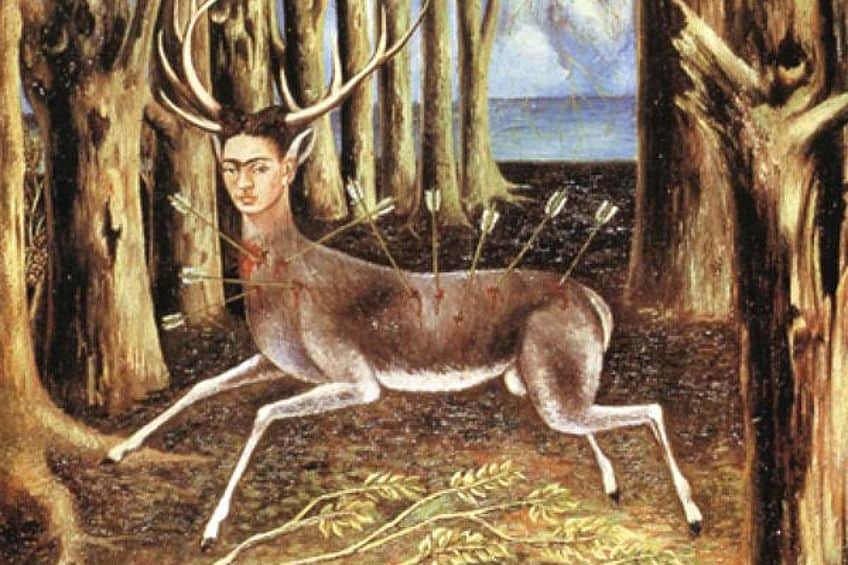“The Wounded Deer” by Frida Kahlo – The Wounded Deer Analysis
Frida Kahlo is known for her highly emotional self-portraits and painting expressions of pain and emotional turmoil. The Wounded Deer by Frida Kahlo is one of this Mexican artist’s most famous self-portraits, and an excellent example of the surrealistic and symbolic qualities that sets her work apart. In this article, we will look at The Wounded Deer painting and complete a The Wounded Deer analysis, to understand more about how Frida Kahlo lived, worked, and expressed herself.
Contents
Artist Abstract: Who Was Frida Kahlo?
Frida Kahlo (1907 – 1954) was a renowned artist from Mexico, celebrated for her striking and symbolic self-portraits that often depicted her personal struggles. Born in 1907 in Coyoacán, Mexico, she spent her childhood in Mexico City. Her mixed heritage, with a German father and a Mexican mother, played a significant role in her art and life.
As a young woman, Kahlo faced various health challenges, including polio, which left her with a limp.
In her teenage years, she was severely injured in a bus crash and spent a year recovering in a full-body cast. During this time, she discovered her passion for art and began experimenting with painting and drawing as a means of expressing her emotions. As she refined her skills, she began to pursue her art more earnestly.

In the early 1920s, she attended the National Preparatory School in Mexico City, where she met Diego Rivera (1886-1957), a well-established muralist whom she would later marry. Despite the age gap and Rivera’s established career, the two were deeply in love, and their relationship was a major source of inspiration for her art. Her paintings, such as The Two Fridas (1939), The Broken Column (1944), The Wounded Deer (1946), The Suicide of Dorothy Hale (1938), and The Dream (1940), explored her physical and emotional pain, her relationship with Rivera, and the cultural and political climate of Mexico in the 1930s and 1940s.
Her work was heavily influenced by Mexican muralists and indigenous culture, and she developed a distinct style and voice through her self-portraits, which became the focal point of her art. In addition to her exploration of the human condition through her self-portraits, Kahlo’s work also had surrealist elements, featuring dreamlike and fantastical imagery. She was closely connected to the Mexican Surrealist movement and her art has been seen as highly symbolic and political, and she has been celebrated as a feminist icon.
Frida Kahlo’s impact on art history is undeniable and her work continues to be studied and celebrated to this day. She is regarded as one of the most significant artists of the 20th century, and her focus on self-expression, emotional pain, and political and social issues still resonates with audiences today.
The Wounded Deer by Frida Kahlo in Context
The Wounded Deer or The Little Deer is one of Frida Kahlo’s renowned self-portraits. Unlike her other famous self-portraits that are normally characterized by Kahlo painting herself from the chest up in typical portrait style, The Wounded Deer painting shows the head and face of Kahlo on the body of a deer.
To understand this strange and emotional painting more, we should take a moment to look at the socio-political context it was created in Mexico, the socio-political context in America where Frida was gaining recognition at the time, and look at the painting in the context of Kahlo’s career and life.
| Date | 1946 |
| Medium | Oil on masonite |
| Type of Painting | Self-portrait |
| Movement | Surrealism and Symbolism |
| Dimensions (cm) | 30 x 22 |
| Location | Private collection of Carolyn Farb, Houston, Texas, United States |
The Wounded Deer by Frida Kahlo in Context of Her Life
The Wounded Deer painting was created during a time of great personal disruption for the artist. Kahlo had just undergone a spinal surgery that left her bedridden for several months, and she was struggling with chronic pain and depression. During this period, she turned to painting as a way to express her pain and emotions.
Kahlo’s work during this period was heavily influenced by her own personal experiences, and The Wounded Deer painting is no exception. During this time in her life, Kahlo also produced several other works that dealt with similar themes of pain, suffering, and resilience. Some of these works include The Two Fridas (1939) and The Broken Column (1944), which also depict the artist’s own body in a state of pain and vulnerability. These paintings are often considered self-portraits, and express the deeply personal struggles that Kahlo was experiencing at the time.
When comparing The Wounded Deer to other works Kahlo produced around the same time, it can be seen as a continuation of her exploration of the human body and its fragility. The painting is a powerful commentary on the human experience of discomfort and despair, but also the resilience and beauty that can be found even in the darkest of moments.
Contextual Analysis: A Brief Mexican Socio-Historical Overview of The Wounded Deer by Frida Kahlo
The Wounded Deer painting was created in 1946, a time of consequential political and social uproar in Mexico. The country had just emerged from a decade-long period of political turmoil, during which a series of leaders had attempted to bring about social and economic change. The Mexican Revolution (1910 – 1920), which aimed to bring about land reform and greater rights for the working class, had officially ended but its ideals and promises were yet to be fully fulfilled.
During this time, many artists and intellectuals in Mexico began to look to the country’s indigenous and pre-Columbian past for inspiration.
They sought to create a new art that would reflect the Mexican identity and break away from the European-influenced art that had been dominant in the country for centuries. This artistic movement, known as Mexican Muralism, was led by artists such as Diego Rivera, Jose Clemente Orozco (1883 – 1949), and David Alfaro Siqueiros (1896 – 1974), and aimed to create art that would educate and inspire the Mexican people.

Frida Kahlo, who was part of this artistic movement, also sought to create art that reflected the Mexican identity and experience. The Wounded Deer painting is a particularly powerful example of this, as it draws on Mexican folklore as well as Kahlo’s lived experience. The painting could be interpreted as a powerful commentary on the Mexican experience of the time, depicting the pain and suffering of the Mexican people, but also the resilience and beauty that can be found even in the darkest of moments.
The painting also reflects the nation’s struggles and aspirations, its wounds, and its search for beauty and meaning.
Contextual Analysis: A Brief Western Socio-Historical Overview of The Wounded Deer by Frida Kahlo
The Wounded Deer painting was first exhibited in the United States in the Museum of Modern Art in New York in the same year it was created. At the time, the United States was undergoing significant socio-political changes, as the country was adjusting to the end of World War II and the beginning of the Cold War. The country was also experiencing a cultural shift, with the rise of Abstract Expressionism and the beginning of the Civil Rights Movement.
In this context, The Wounded Deer painting by Frida Kahlo, can be seen as a representation of the physical and emotional pain that she experienced throughout her life, as well as a commentary on the political and social issues of Mexico and the United States – where she was becoming more famous as an exotic expressive Mexican painter.
The pain and suffering in the painting resonated with many of the post-World War avant-garde art movements that were developing at the time. Many artists around the world, including specifically American artists, were struggling to make sense of the violence and trauma left in the wake of the war. In this way, Frida was speaking directly to the struggles of so many American individuals even though her art was so overtly and purposefully Mexican.
The Wounded Deer Analysis
In this section of the article, we will do an in-depth visual The Wounded Deer analysis (also titled The Little Deer). By looking at the composition structure, subject matter, light and color use, perspective, and symbolism Frida Kahlo applied in creating this artwork, we might gain insight into what made her such a prolific artist.
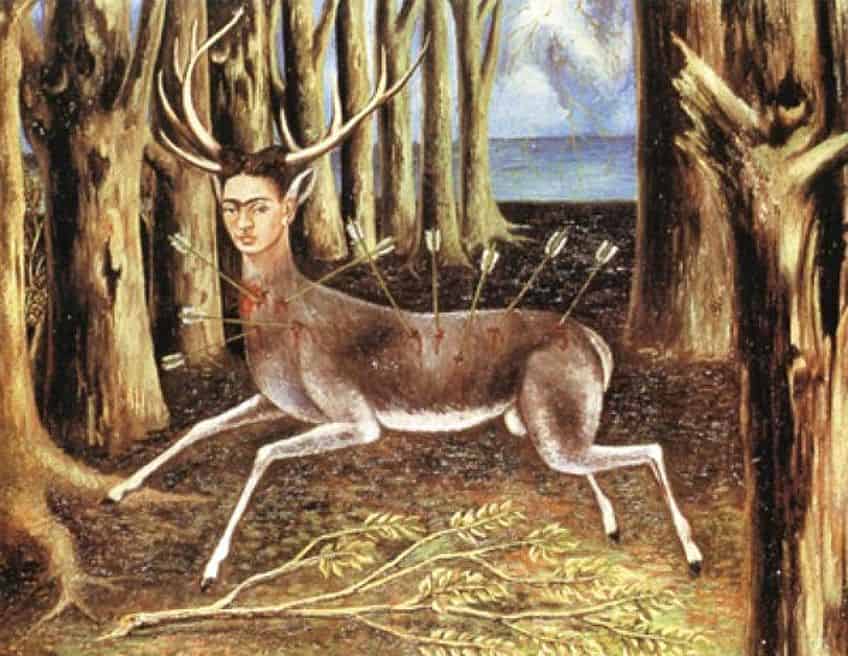
Compositional Overview
The painting depicts Frida Kahlo’s head on the body of a deer. The deer is wounded by nine arrows that are still in its body. These wounds are depicted in great detail, with blood spurting out of them. The face of Frida Kahlo is turned towards the viewer and she is gazing directly at us – with her characteristically stoic face. That being said, there is something in her gaze that communicates nobility, vulnerability, as well as dignity.
From her head an impressive set of antlers is growing and around her deer body is a forest.
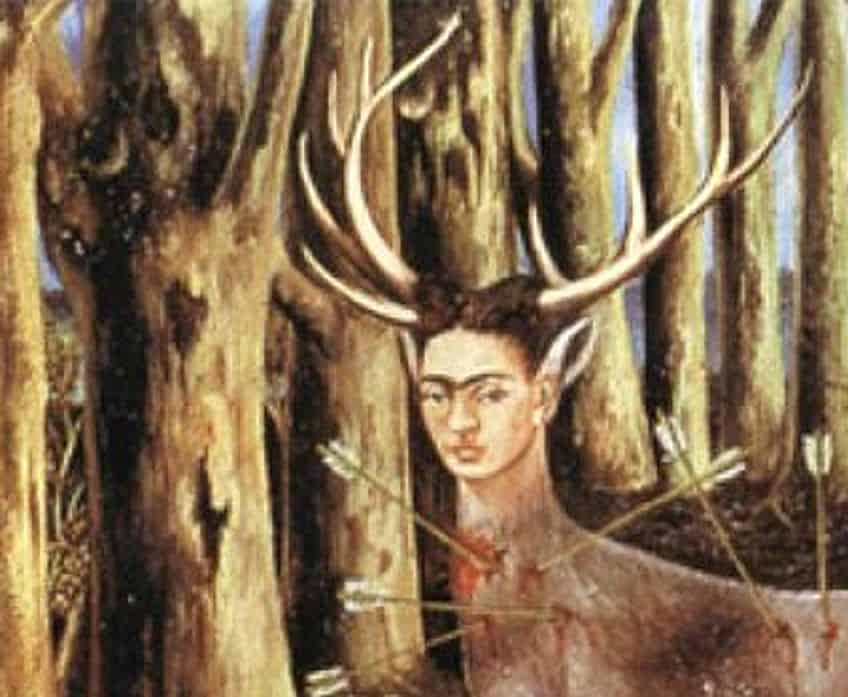
In Frida Kahlo’s painting The Wounded Deer, the composition is centered around a deer. The deer self-portrait is further emphasized by a broken brand lying at its feet. This branch creates a triangle composition with Frida’s antlers, drawing the eyes of the viewer slightly off-center towards the upper-middle left where her face is staring back at you.
This adds to a feeling of unease, confrontation, and drama.
Subject Matter
As mentioned before, the subject matter of the painting is Frida Kahlo’s struggle with physical pain and the emotional turmoil that came with being impaired by her injuries. The nine arrows are slowly killing the deer, representing Frida’s inevitable doom at the demise of her continuous health issues. Furthermore, as often characterized by Frida’s expressions of pain, the symbols of her physical pain also double up as representative of the pain Diego caused her. At that time in their marriage, Diego had cheated on Kahlo many times, with Kahlo retaliating by also having romantic affairs.
This emotional and passionate feud caused the artist a lot of pain and often led to paintings exploring her emotional anguish.
Color and Light
The color palette of the painting is mostly dark and muted, with the exception of the deer’s wounds which are depicted in vibrant reds and oranges. The dark background creates a sense of mystery and intrigue, while the bright colors of the wounds draw the viewer’s attention to the focal point of the painting.
The lighting in the painting is mostly natural, with the exception of a bright light that shines on the deer’s wounds, face, and antlers highlighting them and making them stand out.
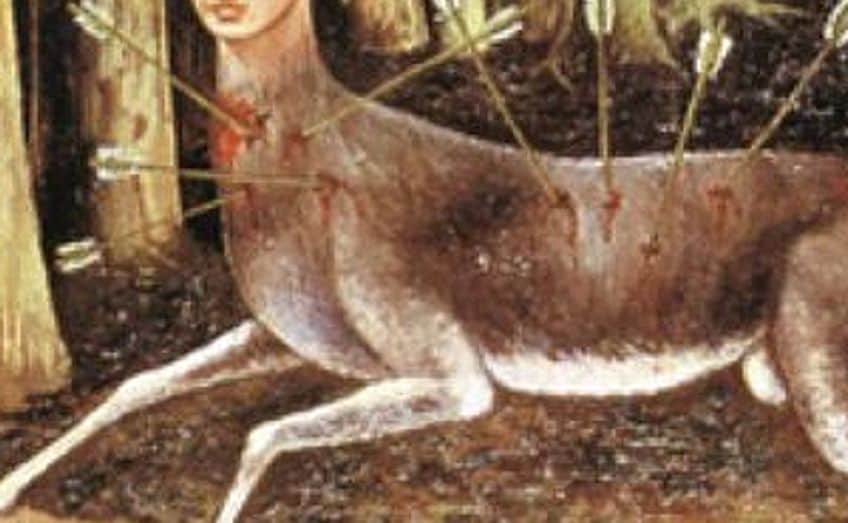
Texture
The texture in the painting is mostly smooth and detailed, with the deer’s fur being depicted in great detail. The blood and wounds are also depicted with great realism, giving the impression of a real and tangible object. The forest, water, and sky around the deer’s body are also depicted with great detail, adding a sense of delicacy to the painting.

Perspective
The perspective in the painting is mostly frontal, with the deer being depicted from its side. This creates a sense of immediacy and closeness with the viewer. The legs of the deer are stretched out, with one foot slightly lifted, this creates a sense of movement and tension.
Besides its animated stance, the deer is quite stationary highlighting Frida Kahlo’s vulnerability and helplessness.
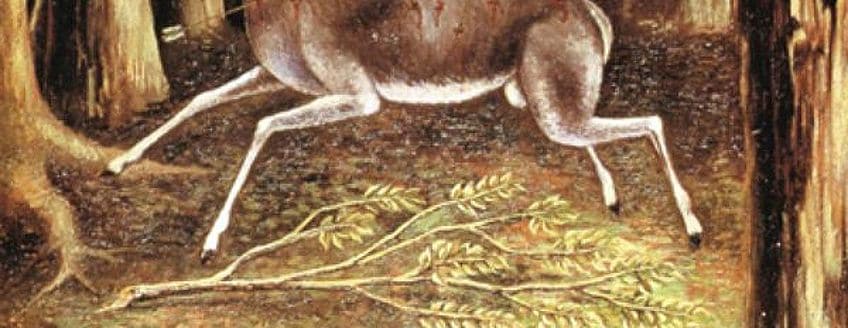
Symbolism: The Wounded Deer Meaning
The painting is full of symbols, as mentioned in the previous sections of the article. Besides the connection to her Mexican roots, the politics in her country at the time, the socio-political state of the world post World War Two, her physical health struggles, emotional pain, and desires to escape the limits of her body, The Wounded Deer is so full of symbols it could easily be interpreted as a Symbolist or Surrealist painting. Let us just focus on the layered interpretation of the deer – as it is the focal point of the painting and also the strangest element included by Kahlo. The deer symbol represents the human body and its fragility. The bleeding deer also evokes the idea of pain and suffering. Furthermore, the deer symbol was inspired by the Aztec beliefs of half-human half-animal entities. These entities symbolized themes of death and rebirth – the continuity of life.
Therefore, the symbol of the deer could have been appropriated by Kahlo to symbolize her persistence in life and the strength she drew from her pain – or the hope that she would be reborn without it.
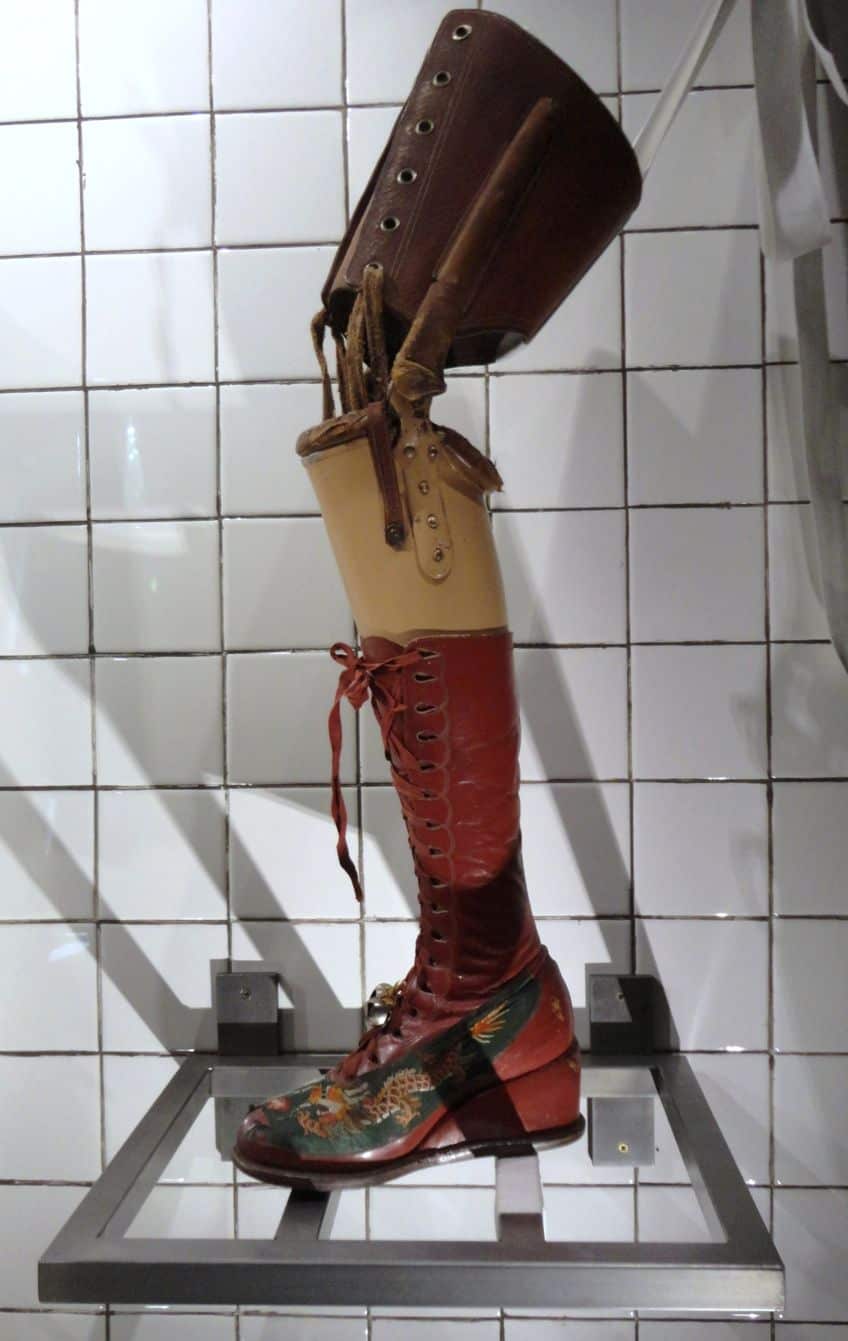
The Aztecs also believed that human babies had an animal double and that some humans could change into their animal counterparts. Frida Kahlo also believed that she could undergo metamorphosis and change into an animal – in this case, a deer. This idea of half-human entities is continued into modern Mexican culture, which is still largely underpinned by the indigenous beliefs that everything in the natural world is connected.
In The Wounded Deer painting, Frida is showing her interpretation of this idea.
Why Is The Wounded Deer by Frida Kahlo So Influential?
The Wounded Deer by Frida Kahlo is considered a powerful and revolutionary work for several reasons. Besides the influence it had on the Surrealist and Symbolist artists to follow, it also shocked the art audience at the time in terms of its subject matter.
The painting is deeply personal and reflects the artist’s own physical and emotional pain. At the time it was created, the painting was considered revolutionary in the way it depicted a woman’s experience of pain and suffering. Frida Kahlo’s work was not typical of the art of her time, which often focused on the male gaze and idealized representations of women. Her paintings were deeply personal, and often depicted her own physical and emotional pain, which was a powerful statement in a culture that often denied or marginalized women’s experiences.
Additionally, the painting is a self-portrait, which is also considered a revolutionary act for a woman in the 1940s. Frida’s self-representation in this painting and others was not only a way of claiming agency over her own image but also a way to express her own identity and her own perspective.
The Critics’ Opinion and the Reception at the First Exhibition
The Wounded Deer painting was first exhibited in 1946 at the National Preparatory School in Mexico City. The painting was part of a solo exhibition of Kahlo’s works, which was her first major exhibition in her home country. The exhibition was widely attended and received significant attention from the public, who were fascinated by the unique and powerful imagery in Kahlo’s paintings.
Many art critics praised the exhibition, particularly singling out The Wounded Deer as a powerful and striking work.
One critic, Octavio Paz (1914 – 1998), wrote in his review of the exhibition, “Kahlo’s paintings are a cry of pain, but they are also a hymn to life. The deer in The Wounded Deer is a symbol of the human body and its fragility, but it is also a symbol of beauty and resilience. The painting is a powerful testament to the artist’s ability to find beauty in even the darkest and most painful moments.”
Another critic, Carlos Monsivais (1938 – 2010), also praised the exhibition, writing, “Frida Kahlo’s paintings are a revelation. They are raw, honest, and deeply personal. The Wounded Deer is a particularly striking work that captures the beauty and fragility of the human body in a powerful and moving way.”
However, not all critics were impressed with the exhibition. Some criticized Kahlo’s work for being overly self-indulgent and lacking in technical skills.
One critic, Jose Clemente Orozco (1883 – 1949) wrote, “Kahlo’s paintings are nothing more than a diary of her own personal struggles. They lack the technical skill and formal sophistication of true art.” Despite the mixed reactions, Frida Kahlo’s exhibition at the National Preparatory School was a significant event in the art world and marked the emergence of a powerful and unique artist.
From this The Wounded Deer analysis, we can see why Frida Kahlo is considered a prolific artist. Her work is still relevant and appreciated by many people today, especially The Wounded Deer, as it speaks to themes of pain and suffering but also courage and dignity. This painting is a testimony of a powerful and determined woman who faced many obstacles but always remained true to herself and her art. Her works continue to inspire and captivate audiences around the world.
Take a look at our the wounded deer painting webstory here!
Frequently Asked Questions
What Is The Wounded Deer Painting About?
The Wounded Deer (1946) by Frida Kahlo (1907 – 1954) depicts a deer, which is a recurrent symbol of Kahlo’s work. The deer has arrows piercing its body, representing the physical pain she suffered as a result of a bus accident she had in her youth. The arrows can also symbolize the pain she experienced because of her tumultuous relationship with her husband, Diego Rivera (1886 – 1957). The deer’s eyes express deep emotional pain and vulnerability, which reflects Kahlo’s own feelings of suffering and isolation. The painting also has a strong feminist message, as it portrays the deer as a powerful yet vulnerable creature, challenging traditional gender roles and societal expectations.
Why Is The Wounded Deer by Frida Kahlo So Influential?
Frida Kahlo’s (1907 – 1954) The Wounded Deer painting is considered revolutionary for its deeply personal and raw portrayal of a woman’s experience of pain and suffering, its feminist message, and the way it challenges traditional gender roles and societal expectations. It was a powerful statement that pushed the boundaries of what was considered acceptable art at the time.
Why Is Frida Kahlo Considered a Prolific Artist Today?
Frida Kahlo (1907 – 1954) is considered a prolific artist, even decades after her death, due to a number of factors. First and foremost, Kahlo’s art is deeply personal and emotionally powerful. Her paintings are deeply intimate and honest, and they resonate with audiences who can relate to the feelings of pain and vulnerability that they depict. Kahlo was also a trailblazer as a female artist in a male-dominated art world. She faced significant obstacles and discrimination throughout her career, but she persevered and created a body of work that is now considered among the most important of the 20th century. Her determination and talent helped pave the way for future generations of female artists.
Nicolene Burger, a South African multimedia artist and creative consultant, specializes in oil painting and performance art. She earned her BA in Visual Arts from Stellenbosch University in 2017. Nicolene’s artistic journey includes exhibitions in South Korea, participation in the 2019 ICA Live Art Workshop, and solo exhibitions. She is currently pursuing a practice-based master’s degree in theater and performance. Nicolene focuses on fostering sustainable creative practices and offers coaching sessions for fellow artists, emphasizing the profound communicative power of art for healing and connection. Nicolene writes blog posts on art history for artfilemagazine with a focus on famous artists and contemporary art.
Learn more about Nicolene Burger and about us.
Cite this Article
Nicolene, Burger, ““The Wounded Deer” by Frida Kahlo – The Wounded Deer Analysis.” artfilemagazine – Your Online Art Source. February 1, 2023. URL: https://artfilemagazine.com/the-wounded-deer-by-frida-kahlo/
Burger, N. (2023, 1 February). “The Wounded Deer” by Frida Kahlo – The Wounded Deer Analysis. artfilemagazine – Your Online Art Source. https://artfilemagazine.com/the-wounded-deer-by-frida-kahlo/
Burger, Nicolene. ““The Wounded Deer” by Frida Kahlo – The Wounded Deer Analysis.” artfilemagazine – Your Online Art Source, February 1, 2023. https://artfilemagazine.com/the-wounded-deer-by-frida-kahlo/.


